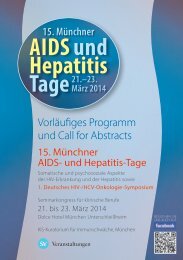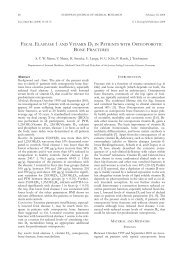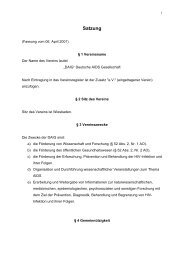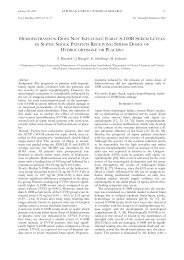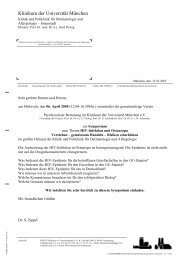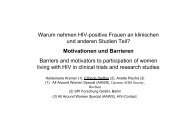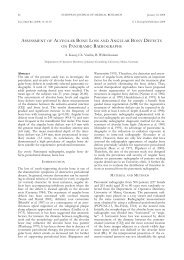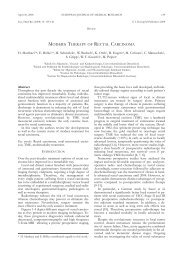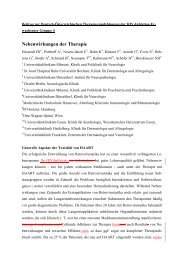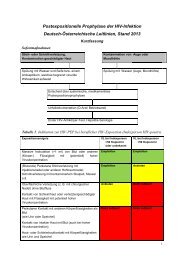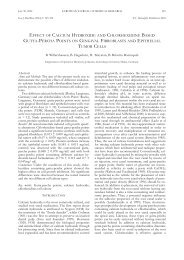European Journal of Medical Research - Deutsche AIDS ...
European Journal of Medical Research - Deutsche AIDS ...
European Journal of Medical Research - Deutsche AIDS ...
You also want an ePaper? Increase the reach of your titles
YUMPU automatically turns print PDFs into web optimized ePapers that Google loves.
June 27, 2007 EUROPEAN JOURNAL OF MEDICAL RESEARCH<br />
27<br />
following a list <strong>of</strong> resistance associated mutations proposed<br />
by Bennet et al. (13th CROI; 2006). This algorithm classifies<br />
mutations as resistance relevant, which meet the following<br />
criteria: Mutations should be associated with HIV drug resistance<br />
and selected by ART, non-polymorph and applicable<br />
to all subtypes. Results <strong>of</strong> both methods were compared.<br />
Non-B subtypes were additionally analysed with NCBI subtype<br />
tool.<br />
Results: The following subtypes were determined: B (212;<br />
80%), A (6; 2.3%), D (12; 4.5%), C (4; 1.5%), G (2; 0.8%), K<br />
(1; 0.4%), CRF02_AG (10; 3.8%), CRF01_AE (10; 3.8%),<br />
CRF05_DF (2; 0.8%), CRF06_CPX (2; 0.8%), CRF08 (1;<br />
0.4%), PR:F/RT:B (2; 0.8%) and 14BG (1; 0.4%)(Table1).<br />
Conclusion: In this study the prevalence <strong>of</strong> primary resistance<br />
in Germany is 10.2% (Stanford) or 8.7% (Bennett). The<br />
results <strong>of</strong> the two different algorithms differ slightly, due to<br />
the fact that Stanford db regards other additional secondary<br />
mutations and thus found more isolates with PI mutations<br />
than Bennett. Most resistance mutations were found against<br />
NRTIs and least against PIs. 2% <strong>of</strong> all patients have resistance<br />
mutations against more than one drug-class. The analysis <strong>of</strong><br />
HIV-Subtype becomes more important in Germany, since<br />
every fifth patient is infected with HIV non-B subtype.<br />
A.4 (Poster)<br />
Establishing large-scale cohorts in Africa to<br />
prepare for HIV vaccine efficacy trials<br />
Price M. 1 , Kamali A. 2 , Karita E. 3 , Anzala O. 4 ,<br />
Mwangome M. 5 , Sanders E. 6 , Bekker L. 7 , Gilmour J. 8 ,<br />
Fast P. 8 , Amornkul P. 9 , Stevens G. 8 , Imambao M. 10 ,<br />
Kenkewa W. 10 , Middlekoop K. 7 , Ruzagira E. 2 ,<br />
Kayitenkore K. 11 , Vwalika C. 10 , Lakhi S. 10 , Mutua G. 4 ,<br />
Byabagambi J. 2 , Kebba A. 2<br />
1 International Aids Vaccine Initiative, R&D, San Mateo,<br />
United States <strong>of</strong> America, 2 Med Res Council/Uganda Virus<br />
Res Inst, Masaka and Entebbe, Entebbe, Uganda, 3 Rwanda<br />
Zambia HIV Res Group, Kigali and Lusaka, Lusaka, Zambia,<br />
4 Kenya Aids Vaccine Initiative, Nairobi, Kenya, 5 Kenya<br />
<strong>Medical</strong> <strong>Research</strong> Institute, Kifili, Kenya, 6 Oxford University,<br />
Oxford, United Kingdom, 7 Univ <strong>of</strong> Cape Town, Desmond<br />
Tutu HIV Ctr, Cape Town, South Africa, 8 International Aids<br />
Vaccine Initiative, New York, United States <strong>of</strong> America,<br />
9 International Aids Vaccine Initiative, Nairobi, Kenya,<br />
10 Rwanda Zambia HIV Res Group, Kigali and Lusaka, Kigali,<br />
Rwanda, 11 Rwanda Zambia HIV Res Group, Kigali and<br />
Lusaka, Kifili, Rwanda<br />
Objectives: To develop cohorts and collect data on HIV-related<br />
risk behaviors, HIV incidence, cohort recruitment and<br />
retention for future HIV vaccine efficacy trials.<br />
Methods: Since 2004, eight sites in east and southern Africa<br />
have developed clinical, laboratory, and counseling capacity<br />
to prepare for large-scale HIV vaccine trials in collaboration<br />
with IAVI. After providing informed consent, adult, HIV-negative<br />
potential trial volunteers are recruited, receive HIV voluntary<br />
counseling and testing, and are followed quarterly. Demographic<br />
and risk behavior data are collected through structured<br />
questionnaires; specimens are collected for HIV-testing.<br />
Table1. 4 two-class resistances and 1<br />
triple-class resistance were found.<br />
Volunteers who become HIV-infected are followed to collect<br />
viral and immunopathogenesis information on early HIV infection.<br />
All sites operate according to good clinical and laboratory<br />
practices.<br />
Results: As <strong>of</strong> January 2007, 5,615 at-risk volunteers are enrolled:<br />
2,783 (50%) HIV-discordant couples, 1184 (21%) rural<br />
residents in high HIV-prevalence area, 178 (3%) men who<br />
have sex with men (MSM), and 1,196 (21%) other at-risk participants.<br />
With over 8,500 person-years <strong>of</strong> observation (PY),<br />
HIV incidence in sites with more than 100 PY ranged from<br />
1.0 to 11.3 cases/100 PY. Despite shorter duration <strong>of</strong> followup,<br />
MSM have the highest incidence, 8.2 cases/100PY. Over<br />
160 volunteers with a documented duration <strong>of</strong> HIV-infection<br />
<strong>of</strong> less than 385 days are being followed.<br />
Conclusions: Eight sites in sub-Saharan Africa have successfully<br />
engendered research facilities capable <strong>of</strong> recruiting thousands<br />
<strong>of</strong> potential volunteers for vaccine clinical trials. The<br />
lessons learned from this work will guide the development <strong>of</strong><br />
upcoming efficacy trials.<br />
A.5 (Vortrag)<br />
Entwicklung von Morbidität und Mortalität in der<br />
Frankfurter Kohorte<br />
Stephan C. 1 , Khaykin P. 1 , Staszewski S. 1 , Klauke S. 2 ,<br />
Gute P. 3 , Helm E.B. 1<br />
1 HIVCENTER, Klinikum der Johann Wolfgang Goethe-<br />
Universität, Frankfurt, Germany, 2 IFS Praxis Stresemannallee,<br />
Frankfurt, Germany, 3 HIV Schwerpunkt-Praxis<br />
Friedensstrasse, Frankfurt, Germany<br />
Ziel: Identifikation von Trends in der HIV-Epidemiologie anhand<br />
einer Kohorte.<br />
Methodik: Analyse von Morbiditätsfaktoren und Mortalität<br />
bei 9000 HIV-infizierten Patienten der Frankfurter Kohorte ab<br />
1982.<br />
Ergebnis: Bis Ende des Jahres 2006 waren im untersuchten<br />
Kollektiv rund 2900 Patienten an <strong>AIDS</strong> erkrankt. Insgesamt<br />
sind bis Ende 2006 ca. 1900 gestorben, 320 vor Erreichen des<br />
Stadiums <strong>AIDS</strong>. Seit 1996 wird ein kontinuierlicher Rückgang<br />
der <strong>AIDS</strong>-Inzidenz in der Kohortenpopulation beobachtet.<br />
Der Anteil der Frauen beträgt in den letzten Jahren nahezu<br />
unverändert 20-25%. Die Zahl der Erstvorstellung i.v.-Drogenabhängiger<br />
Patienten hat seit dem Jahr 2000 deutlich<br />
abgenommen, nicht aber der Anteil an den <strong>AIDS</strong>-Patienten<br />
des Gesamtkollektivs. Der Anteil der Migranten aus Endemiegebieten<br />
an den HIV-Infizierten hat seit Mitte der<br />
1990er Jahre zugenommen, heute hat jeder vierte Patient der<br />
Frankfurter Kohorte einen Migrationshintergrund. Unter den<br />
<strong>AIDS</strong>-definierenden Erkrankungen sind klassische Diagnosen<br />
wie PCP und Kaposi-Sarkom seltener geworden, während<br />
maligne Lymphome und Tuberkulose zunehmen. Unter den<br />
Todesursachen sind die <strong>AIDS</strong>-definierenden Erkrankungen<br />
seltener; zunehmend werden kardiovaskuläre und onkologische<br />
Erkrankungen beobachtet; dem zahlenmäßigen Rückgang<br />
der i.v.-Drogenabhängigen unter den <strong>AIDS</strong>-Patienten folgend,<br />
nimmt auch die Todesursache Leberzirrhose in den letzten<br />
beiden Jahren wieder ab.



